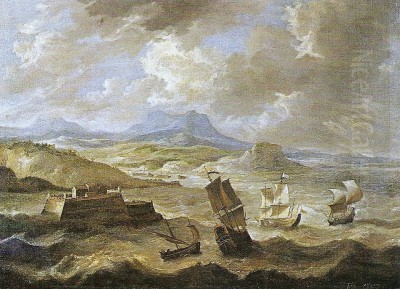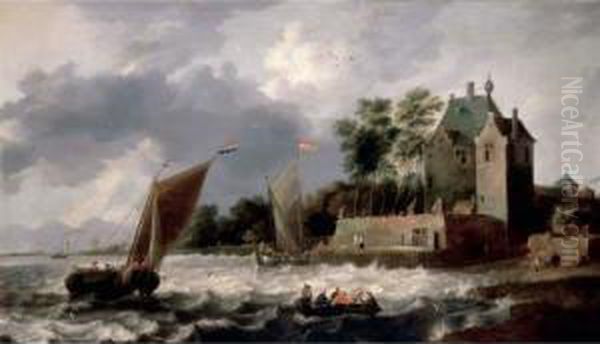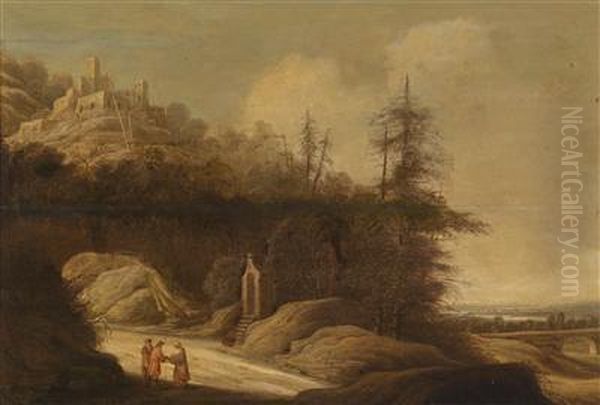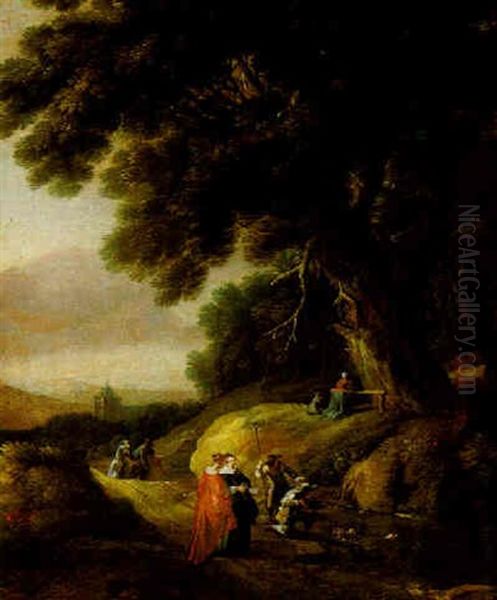
Gillis Peeters I, also known historically as Egidius Peeters the Elder, stands as a significant, if sometimes overlooked, figure in the rich tapestry of 17th-century Flemish Baroque art. Born in the bustling artistic hub of Antwerp in 1612 and passing away in the same city in 1653, Peeters carved a niche for himself primarily as a painter of landscapes and marine scenes, though his oeuvre also includes mythological subjects and, according to some sources, still lifes. His work is characterized by a keen observation of nature, a penchant for detailed rendering, and an ability to infuse his scenes with both atmospheric depth and narrative interest.
Peeters was part of an artistic dynasty, a common phenomenon in the tightly-knit art world of Antwerp. His contributions, while perhaps not as globally renowned as some of his towering contemporaries, offer a valuable window into the diverse artistic currents of his time, showcasing a blend of local traditions and broader European influences.
Early Life and Artistic Formation in Antwerp
Gillis Peeters I was baptized in Antwerp on May 12, 1612. He was born into a family deeply embedded in the city's artistic community. His father, Cornelis Peeters, was a master painter and a member of the prestigious Guild of Saint Luke in Antwerp, the city's official organization for painters, sculptors, engravers, and other craftsmen. This familial connection undoubtedly provided Gillis and his siblings with their initial exposure to the world of art and their foundational training.
It is widely accepted that Gillis, along with his brothers Bonaventura Peeters I (the Elder) and Jan Peeters I, received their primary artistic education from their father. The Peeters family operated a workshop, a common practice where apprentices and family members collaborated on commissions and developed their skills under the guidance of a master. This environment fostered a shared learning experience and often led to stylistic similarities and collaborative efforts among family members.

Antwerp in the early 17th century was a vibrant, albeit politically complex, city. Despite the economic challenges following the Dutch Revolt and the Scheldt blockade, it remained a leading center for the arts in Europe. The towering figure of Peter Paul Rubens dominated the artistic landscape, his dynamic Baroque style influencing generations of painters. The city was also home to other luminaries such as Anthony van Dyck and Jacob Jordaens, creating an environment of intense artistic activity and high standards.
The Guild of Saint Luke and Professional Recognition
Like most aspiring professional artists in Antwerp, Gillis Peeters I sought membership in the Guild of Saint Luke. He was officially registered as a master in the guild records for the guild year 1634–1635. This was a crucial step in an artist's career, as it granted them the right to take on apprentices, sell their works publicly, and receive official commissions. His brother Bonaventura had become a master in the same guild in the guild year 1633–1634.
The Guild of Saint Luke played a vital role in maintaining artistic standards, regulating trade, and providing a social and professional network for its members. Membership signified a recognized level of competence and professionalism. For Gillis, this would have solidified his standing within the Antwerp art community and opened doors for further artistic endeavors.
Artistic Style: Flemish Realism and Italianate Echoes
Gillis Peeters I developed a style that, while rooted in the Flemish tradition of meticulous realism, also showed an awareness of broader European trends, particularly the Italianate landscape style. His works are often characterized by a careful attention to detail, especially in the rendering of foliage, water, and atmospheric effects.
His landscapes frequently depict idyllic rural scenes, often with a low horizon line that emphasizes the expanse of the sky. These scenes are populated with small figures – peasants, travelers, or mythological characters – that add narrative interest but rarely dominate the natural setting. There's a sense of tranquility and a deep appreciation for the beauty of the countryside in these works. The coloration is often rich, with a harmonious balance of greens, blues, and earthy tones, though some works exhibit the softer, more tonal palette seen in contemporary Dutch landscape painting.

The "Italianate" influence in some of Peeters' landscapes refers to the adoption of motifs and stylistic features associated with Italian scenery and art, even if the artist himself may not have traveled to Italy (records of such a journey are scarce). This could include the depiction of classical ruins, sun-drenched Mediterranean light, and a more idealized, pastoral vision of nature, often inspired by artists like Claude Lorrain or Nicolas Poussin, whose works were known in the North through prints or originals.
In his marine paintings, Peeters demonstrated a strong understanding of ships and the sea. These works range from calm coastal views and estuary scenes to more dramatic depictions of ships in choppy waters. He captured the reflective qualities of water and the dynamic forms of sailing vessels with considerable skill, a talent shared and perhaps even surpassed by his brother Bonaventura, who became one ofthe leading marine painters of his generation.
Key Themes and Subjects
Gillis Peeters I explored several popular themes within his artistic practice, showcasing his versatility.
Landscapes: Pastoral and Mythological
Rural landscapes form a significant portion of Gillis Peeters' output. These often feature winding rivers, wooded areas, and distant villages, creating a sense of depth and inviting the viewer into the scene. His 1640 painting, often titled Rural Landscape or Landscape with Mythological Scene, is a prime example. It combines a meticulously rendered natural environment, rich in diverse trees, plants, and animals (including birds), with figures that suggest a story from classical mythology. This blending of genres was common in the Baroque period, allowing artists to elevate landscape painting by associating it with more prestigious historical or mythological themes. The attention to botanical and zoological detail in such works is a hallmark of the Flemish tradition, harking back to artists like Jan Brueghel the Elder.
Marine Paintings and Coastal Scenes

Given Antwerp's history as a major port (though its access was restricted during this period), and the Dutch Republic's flourishing maritime trade, marine painting was a popular genre. Gillis Peeters contributed significantly to this field. His Estuary Scene is a notable work, praised for its depiction of the Dutch coast, its effective use of perspective to create depth, and its skillful handling of light and shadow to enhance the dynamism of the water and sky. These scenes often included various types of ships, from humble fishing boats to larger merchant vessels, rendered with an eye for nautical accuracy. His brother Bonaventura Peeters I was a renowned specialist in this genre, and it's likely the brothers influenced each other and perhaps even collaborated on marine subjects. Other marine painters active in this period included Dutch artists like Jan Porcellis and Simon de Vlieger, whose innovations in depicting atmospheric conditions at sea were influential.
Still Lifes
While primarily known for landscapes and seascapes, some sources suggest Gillis Peeters I also painted still lifes. If so, these would likely have followed the prevailing trends in Antwerp, which was a major center for still life painting, with masters like Frans Snyders (known for his large game and market scenes) and Jan Davidsz. de Heem (famous for his opulent floral and fruit pieces) setting high standards. Peeters' still lifes, as described, focused on everyday objects like fruits, flowers, and silverware, characterized by clear compositions and soft colors. This aspect of his work, however, is less documented and less prominent than his landscapes.
Historical and Topographical Works
A significant commission for Gillis Peeters I was his involvement in a series of paintings depicting the Battle of Calloo (or Siege of Calloo). This event, a Spanish victory over Dutch forces near Antwerp in 1638, was of considerable local importance. Peeters was one of several artists commissioned by the Antwerp municipal authorities to commemorate it. This indicates his standing as an artist capable of handling large-scale historical or topographical subjects, a genre often considered among the most prestigious. Such commissions required not only artistic skill but also the ability to work to a brief and often collaborate with other artists or advisors.
Notable Works in Detail
Several works by Gillis Peeters I are frequently cited and help to illustrate his artistic contributions.
Rural Landscape (1640)
This painting, sometimes identified with specific mythological content, exemplifies Peeters' skill in creating lush, detailed landscapes. The composition typically draws the eye through a carefully constructed foreground, often featuring prominent trees or a riverbank, into a receding middle ground and a distant, hazy background. The figures, whether mythological or pastoral, are integrated into the landscape, serving to animate the scene and provide a focal point without overshadowing the natural environment. The meticulous rendering of leaves, bark, and various animal species showcases the Flemish love for detail and verisimilitude. The influence of artists like Jan Brueghel the Elder, known for his "paradise landscapes" teeming with life, can be felt, as can the Italianate tendency towards idealized, harmonious nature.
Estuary Scene
This work, or works of this title, highlights Peeters' abilities as a marine painter. Such scenes typically depict the meeting point of a river and the sea, often featuring a variety of vessels, coastal fortifications, or small harbors. The challenge for the artist lay in capturing the complex interplay of light on water, the movement of waves, and the vastness of the sky. Peeters' Estuary Scene is noted for its successful creation of depth through atmospheric perspective and linear perspective, and for its dynamic use of light and shadow. It has been suggested that for some works, including an Estuary Scene, Gillis Peeters I collaborated with Jan Brueghel the Younger, the son of Jan Brueghel the Elder and another prominent Antwerp painter. Such collaborations were common, with one artist specializing in figures and another in landscape or still life elements.
The Siege of Calloo
Peeters' contribution to the depiction of The Siege of Calloo underscores his engagement with contemporary historical events. These paintings were often large-scale and served a public function, celebrating civic pride or military victories. While the specific details of Peeters' version might vary from others (as multiple artists, including Peter Paul Rubens, also depicted aspects of the Cardinal-Infante Ferdinand's victories around this time), it would have required him to combine topographical accuracy with dramatic composition to convey the significance of the event. This work places him within a tradition of battle and cityscape painters.
Collaborations and Artistic Circle
The art world of 17th-century Antwerp was characterized by close-knit relationships and frequent collaborations. Gillis Peeters I was no exception.
The Peeters Family Workshop
The most significant collaborations for Gillis were undoubtedly with his brothers, Bonaventura I and Jan I. They shared a studio in Antwerp, at least for a period, and likely learned from their father, Cornelis Peeters, together. Bonaventura Peeters I (1614–1652) became a highly respected marine painter, known for his dramatic shipwrecks and exotic coastal views. Jan Peeters I (1624–c. 1677) also specialized in marine paintings and topographical views, traveling extensively and depicting ports and cities from the Mediterranean to the North Sea. The brothers likely shared motifs, techniques, and even assisted each other on larger commissions. This familial artistic environment was a source of both support and, potentially, friendly rivalry.
Jan Brueghel the Younger
The reported collaboration between Gillis Peeters I and Jan Brueghel the Younger (1601–1678) on the Estuary Scene is noteworthy. Jan Brueghel the Younger inherited his father's (Jan Brueghel the Elder) workshop and continued his prolific production of landscapes, allegorical scenes, and flower paintings. Collaborations between landscape specialists and figure painters were standard practice. For instance, Peter Paul Rubens frequently collaborated with Jan Brueghel the Elder, with Rubens painting the figures and Brueghel the landscape and animals. If Peeters collaborated with Jan Brueghel the Younger, it would likely have involved a similar division of labor, perhaps with Brueghel adding figures or specific details to a landscape or seascape primarily executed by Peeters, or vice-versa.
Influence of Peter Paul Rubens
While direct collaboration is not documented, no artist working in Antwerp during this period could escape the immense influence of Peter Paul Rubens (1577–1640). Rubens' dynamic compositions, rich color palette, and mastery of various genres set the standard. While Peeters' style is generally more restrained and less monumental than Rubens', the overall artistic climate shaped by Rubens would have impacted his training, aspirations, and the expectations of patrons. Rubens himself painted powerful landscapes, especially in his later years, which had a profound impact on the genre in Flanders.
Other Antwerp Contemporaries
Gillis Peeters I worked alongside a host of other talented artists in Antwerp. These included:
David Teniers the Younger (1610–1690): A highly versatile and prolific painter known for his peasant scenes, kermesses, guardroom scenes, and landscapes.
Adriaen Brouwer (1605/6–1638): Though Dutch-born, Brouwer spent a significant part of his career in Antwerp and was highly influential with his expressive and often humorous tavern scenes.
Frans Snyders (1579–1657): A leading animal painter and still life specialist, whose large, energetic compositions were highly sought after.
Jacob Jordaens (1593–1678): After Rubens and Van Dyck, Jordaens was the leading Flemish Baroque painter, known for his robust figures and lively genre and mythological scenes.
Jan van Kessel the Elder (1626–1679): A nephew of Jan Brueghel the Younger, known for his highly detailed small-scale paintings of insects, flowers, and allegorical subjects, often on copper.
Gonzales Coques (1614/18–1684): Known as the "little Van Dyck" for his elegant small-scale group portraits and conversation pieces.
While direct interactions with all these figures are not specifically recorded for Gillis Peeters, they formed the competitive and inspiring artistic environment in which he operated. The exchange of ideas, stylistic influences, and even competition for patronage would have been part of his daily professional life.
Challenges and Anecdotes
The life of a 17th-century artist, even one with guild membership and family connections, was not without its challenges.
Technical Mastery
The pursuit of realism in landscape and marine painting demanded considerable technical skill. Accurately depicting the textures of different materials, the effects of light and shadow, the complexities of perspective, and the anatomy of figures and animals required years of dedicated practice. For marine painters like Peeters, understanding the construction of ships and the behavior of water under various weather conditions was crucial.
Market Demands and Patronage
Artists needed to navigate the art market, which could be fickle. While some patrons commissioned specific works, many artists also produced paintings for the open market. This meant anticipating trends and preferences while trying to maintain their artistic integrity. The popularity of certain genres, like landscapes and marine scenes, provided opportunities, but also meant more competition.
The Shadow of Giants
Working in Antwerp at the height of the careers of Rubens, Van Dyck, and Jordaens meant that other talented artists sometimes found it harder to achieve the same level of fame or lucrative commissions. While Gillis Peeters I was a respected master, his name is not as instantly recognizable today as these titans of Flemish art.
Family Dynamics
While the Peeters family workshop provided a supportive environment, working closely with siblings, especially in the same specializations, could also lead to complexities in distinguishing individual contributions or establishing unique artistic identities. Bonaventura, for instance, achieved greater renown as a marine specialist than Gillis.
One anecdote, or rather a point of historical record, is Gillis Peeters' participation in the Dutch Brazil enterprise. Around 1637-1640, he is documented as having traveled to Dutch Brazil, possibly in the entourage of Governor Johan Maurits van Nassau-Siegen, who brought many artists and scientists to document the New World. This journey, if it indeed occurred for Gillis Peeters I (some sources attribute this more strongly to other artists or question the exact Peeters involved), would have been an extraordinary experience, exposing him to entirely new landscapes, flora, and fauna, and potentially influencing his later work. However, definitive visual evidence of Brazilian subjects in his known oeuvre is not overwhelmingly prominent, leading to some scholarly debate about the extent or impact of such a voyage. If he did travel, he would have been among a select group of European artists to experience South America firsthand in this period, alongside figures like Frans Post and Albert Eckhout who were definitively part of Johan Maurits's Brazilian mission.
Later Life and Legacy
Gillis Peeters I continued to work in Antwerp throughout his career. He married Maria de Gorter on May 2, 1638, and they had several children. He is recorded as living in Hoboken, a village near Antwerp, in his later years. He passed away in Antwerp and was buried on September 17, 1653, at a relatively young age of 41.
His legacy lies in his contribution to the Flemish landscape and marine painting traditions. His works are found in various museums and private collections, valued for their craftsmanship, atmospheric qualities, and charming depictions of nature and maritime life. While perhaps overshadowed by his more famous brother Bonaventura in the realm of marine painting, and by the giants of the Antwerp school in general, Gillis Peeters I was a skilled and productive artist who played his part in the rich artistic output of 17th-century Flanders.
His paintings offer a quieter, often more intimate vision compared to the grand drama of some of his contemporaries. They reflect a deep appreciation for the natural world, rendered with a typically Flemish attention to detail and a sensitivity to light and atmosphere. His work, along with that of his brothers and other contemporaries like Andries van Eertvelt (an earlier Flemish marine painter) or later figures like Hendrik van Minderhout, helped to sustain Antwerp's reputation as a center for diverse artistic production.
Conclusion
Gillis Peeters I, or Egidius Peeters the Elder, was a quintessential Flemish Baroque artist of his time: trained within a family workshop, a master in the Guild of Saint Luke, and a skilled practitioner of popular genres. His landscapes, whether pastoral, mythological, or coastal, reveal a painter with a fine eye for detail, a strong sense of composition, and an ability to evoke the specific moods of nature and the sea. His collaborations, particularly with his brothers and potentially with figures like Jan Brueghel the Younger, highlight the interconnectedness of the Antwerp art scene.
Though his career was relatively short, Gillis Peeters I left behind a body of work that continues to be appreciated for its artistic merit. He represents the solid bedrock of talent that underpinned the more spectacular achievements of the Flemish Golden Age, contributing to the rich and varied artistic landscape of 17th-century Europe. His paintings serve as a testament to the enduring appeal of meticulously observed and beautifully rendered scenes of the natural world.